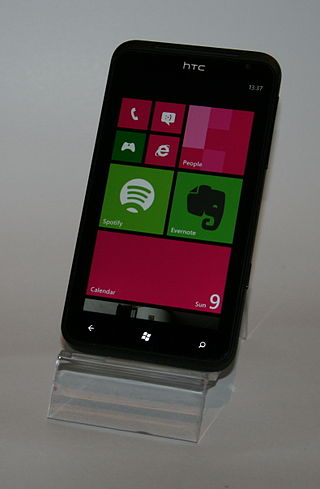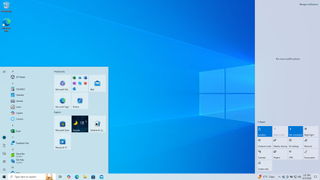Related Research Articles

Microsoft Office, or simply Office, is a family of client software, server software, and services developed by Microsoft. It was first announced by Bill Gates on August 1, 1988, at COMDEX in Las Vegas. Initially a marketing term for an office suite, the first version of Office contained Microsoft Word, Microsoft Excel, and Microsoft PowerPoint. Over the years, Office applications have grown substantially closer with shared features such as a common spell checker, Object Linking and Embedding data integration and Visual Basic for Applications scripting language. Microsoft also positions Office as a development platform for line-of-business software under the Office Business Applications brand.

Windows Live Mesh is a discontinued free-to-use Internet-based file synchronization application by Microsoft designed to allow files and folders between two or more computers to be in sync with each other on Windows and Mac OS X computers or the Web via SkyDrive. Windows Live Mesh also enabled remote desktop access via the Internet.
Microsoft engineering groups are the operating divisions of Microsoft. Starting in April 2002, Microsoft organised itself into seven groups, each an independent financial entity. In September 2005, Microsoft announced a reorganization of its then seven groups into three. In July 2013, Microsoft announced another reorganization into five engineering groups and six corporate affairs groups. A year later, in June 2015, Microsoft reformed into three engineering groups. In September 2016, a new group was created to focus on artificial intelligence and research. On March 29, 2018, a new structure merged all of these into three.

Windows Phone (WP) is a discontinued mobile operating system developed by Microsoft for smartphones as the replacement successor to Windows Mobile and Zune. Windows Phone featured a new user interface derived from the Metro design language. Unlike Windows Mobile, it was primarily aimed at the consumer market rather than the enterprise market.
Midori was the code name for a managed code operating system (OS) being developed by Microsoft with joint effort of Microsoft Research. It had been reported to be a possible commercial implementation of the OS Singularity, a research project begun in 2003 to build a highly dependable OS in which the kernel, device drivers, and application software are all written in managed code. It was designed for concurrency, and could run a program spread across multiple nodes at once. It also featured a security model that sandboxes applications for increased security. Microsoft had mapped out several possible migration paths from Windows to Midori. Midori was discontinued some time in 2015, though many of its concepts were used in other Microsoft projects.
Gazelle was a research web browser project by Microsoft Research, first announced in early 2009. The central notion of the project was to apply operating system (OS) principles to browser construction. In particular, the browser had a secure kernel, modeled after an OS kernel, and various web sources run as separate "principals" above that, similar to user space processes in an OS. The goal of doing this was to prevent bad code from one web source to affect the rendering or processing of code from other web sources. Browser plugins are also managed as principals.

Windows Home Server 2011, code named Vail, is a home server operating system by Microsoft designed for small office/home offices and homes with multiple connected PCs to offer protected file storage, file sharing, automated PC backup, remote access, and remote control of PC desktops. It was released on 6 April 2011 following the release of Power Pack 3 for its aging predecessor, Windows Home Server. Windows Home Server 2011 is the last Windows Home Server release and was succeeded by Windows Server 2012 Essentials.
Microsoft Intune is a Microsoft cloud-based unified endpoint management service for both corporate and BYOD devices. It extends some of the "on-premises" functionality of Microsoft Configuration Manager to the Microsoft Azure cloud.
IFTTT is a private commercial company that runs services that allow a user to program a response to events in the world.
Microsoft mobile services are a set of proprietary mobile services created specifically for mobile devices; they are typically offered through mobile applications and mobile browser for Windows Phone platforms, BREW, and Java. Microsoft's mobile services are typically connected with a Microsoft account and often come preinstalled on Microsoft's own mobile operating systems while they are offered via various means for other platforms. Microsoft started to develop for mobile computing platforms with the launch of Windows CE in 1996 and later added Microsoft's Pocket Office suite to their Handheld PC line of PDAs in April 2000. From December 2014 to June 2015, Microsoft made a number of corporate acquisitions, buying several of the top applications listed in Google Play and the App Store including Acompli, Sunrise Calendar, Datazen, Wunderlist, Echo Notification Lockscreen, and MileIQ.

Windows Phone 7 is the first release of the Windows Phone mobile client operating system, released worldwide on October 21, 2010, and in the United States on November 8, 2010. It runs on the Windows CE 6.0 kernel.

Google Sheets is a spreadsheet application and part of the free, web-based Google Docs Editors suite offered by Google. Google Sheets is available as a web application; a mobile app for: Android, iOS, and as a desktop application on Google's ChromeOS. The app is compatible with Microsoft Excel file formats. The app allows users to create and edit files online while collaborating with other users in real-time. Edits are tracked by which user made them, along with a revision history. Where an editor is making changes is highlighted with an editor-specific color and cursor. A permissions system regulates what users can do. Updates have introduced features that use machine learning, including "Explore", which offers answers based on natural language questions in the spreadsheet. Sheets is one of the services provided by Google that also includes Google Docs, Google Slides, Google Drawings, Google Forms, Google Sites and Google Keep.

Windows 10 is a major release of Microsoft's Windows NT operating system. It is the direct successor to Windows 8.1, which was released nearly two years earlier. It was released to manufacturing on July 15, 2015, and later to retail on July 29, 2015. Windows 10 was made available for download via MSDN and TechNet, as a free upgrade for retail copies of Windows 8 and Windows 8.1 users via the Microsoft Store, and to Windows 7 users via Windows Update. Windows 10 receives new builds on an ongoing basis, which are available at no additional cost to users, in addition to additional test builds of Windows 10, which are available to Windows Insiders. Devices in enterprise environments can receive these updates at a slower pace, or use long-term support milestones that only receive critical updates, such as security patches, over their ten-year lifespan of extended support. In June 2021, Microsoft announced that support for Windows 10 editions which are not in the Long-Term Servicing Channel (LTSC) will end on October 14, 2025.
Windows 10 has several editions, all with varying feature sets, use cases, or intended devices. Certain editions are distributed only on devices directly from an original equipment manufacturer (OEM), while editions such as Enterprise and Education are only available through volume licensing channels. Microsoft also makes editions of Windows 10 available to device manufacturers for use on specific classes of devices, including IoT devices, and previously marketed Windows 10 Mobile for smartphones.
Universal Windows Platform (UWP) is a computing platform created by Microsoft and introduced in Windows 10. The purpose of this platform is to help develop universal apps that run on Windows 10, Windows 10 Mobile (discontinued), Windows 11, Xbox One, Xbox Series X/S, and HoloLens without the need to be rewritten for each. It supports Windows app development using C++, C#, VB.NET, and XAML. The API is implemented in C++, and supported in C++, VB.NET, C#, F# and JavaScript. Designed as an extension to the Windows Runtime (WinRT) platform introduced in Windows Server 2012 and Windows 8, UWP allows developers to create apps that will potentially run on multiple types of devices.
Citrix Virtual Apps is an application virtualization software produced by Citrix Systems that allows Windows applications to be accessed via individual devices from a shared server or cloud system.
Microsoft, a technology company historically known for its opposition to the open source software paradigm, turned to embrace the approach in the 2010s. From the 1970s through 2000s under CEOs Bill Gates and Steve Ballmer, Microsoft viewed the community creation and sharing of communal code, later to be known as free and open source software, as a threat to its business, and both executives spoke negatively against it. In the 2010s, as the industry turned towards cloud, embedded, and mobile computing—technologies powered by open source advances—CEO Satya Nadella led Microsoft towards open source adoption although Microsoft's traditional Windows business continued to grow throughout this period generating revenues of 26.8 billion in the third quarter of 2018, while Microsoft's Azure cloud revenues nearly doubled.
Azure Virtual Desktop (AVD), formerly known as Windows Virtual Desktop (WVD), is a Microsoft Azure-based system for virtualizing its Windows operating systems, providing virtualized desktops and applications securely in the cloud using the Remote Desktop Protocol. It is aimed at enterprise customers rather than at individual users.

Microsoft 365 is a product family of productivity software, collaboration and cloud-based services owned by Microsoft. It encompasses online services such as Outlook.com, OneDrive, Microsoft Teams, programs formerly marketed under the name Microsoft Office, enterprise products and services associated with these products such as Exchange Server, SharePoint, and Viva Engage. It also covers subscription plans encompassing these products, including those that include subscription-based licenses to desktop and mobile software, and hosted email and intranet services.
References
- ↑ Dixon, Colin; Mahajan, Ratul; Agarwal, Sharad; Brush, A.J.; Lee, Bongshin; Saroiu, Stefan; Bahl, Victor (April 2012). "An Operating System for the Home". Microsoft Research – Publications. Microsoft . Retrieved 26 April 2012.
- ↑ Foley, Mary Jo (10 September 2010). "Microsoft experiments with 'HomeOS' and home app store ideas". ZDNet. CBS Interactive. Archived from the original on September 13, 2010. Retrieved 26 April 2012.
- 1 2 "Microsoft had a plan to automate your home before Apple and Google — but never did it". businessinsider.com. 4 December 2015.
- ↑ "Lab of Things Wiki". CodePlex . Microsoft. Archived from the original on 2 February 2015. Retrieved 14 January 2015.
- ↑ Higginbotham, Stacey (15 July 2013). "Microsoft pushes HomeOS further with Lab of Things, but where's the mobile angle?". Gigaom . Archived from the original on 10 March 2015. Retrieved 14 January 2015.
- ↑ Foley, Mary Jo (15 July 2013). "Microsoft adds a Lab of Things to its HomeOS". ZDNet. CBS Interactive. Retrieved 14 January 2015.
- ↑ "HomeOS homepage". Microsoft .
- ↑ ""Microsoft's HomeStore: Home automation, with an iPhone-inspired twist"". zd.net. 7 October 2010.